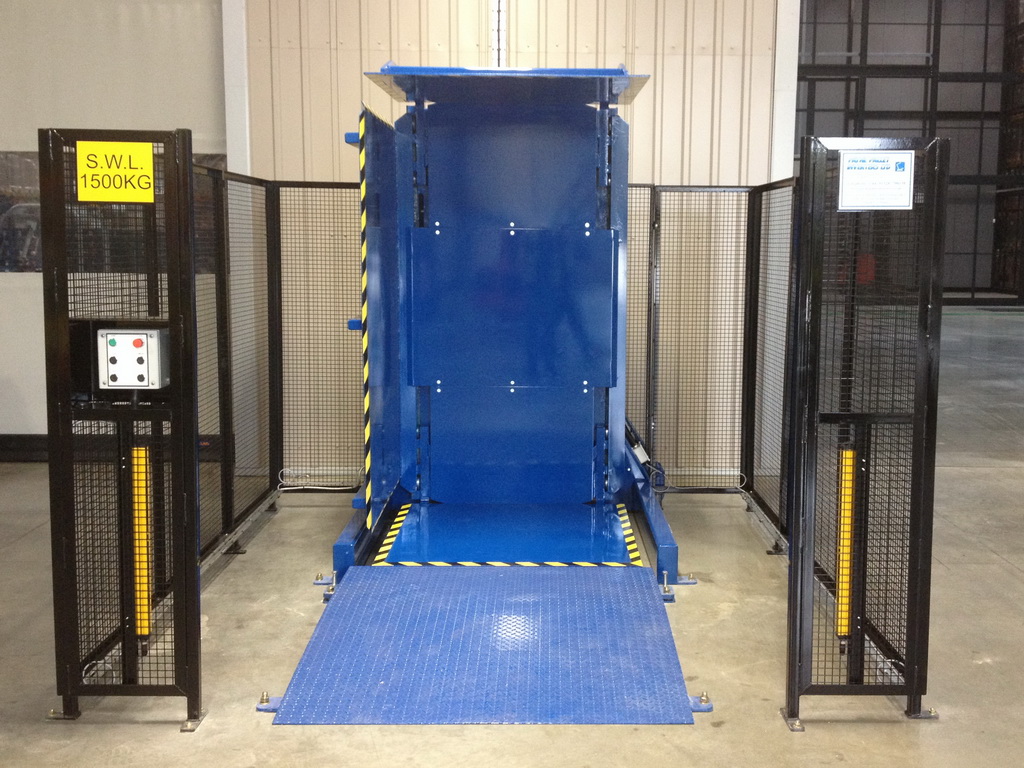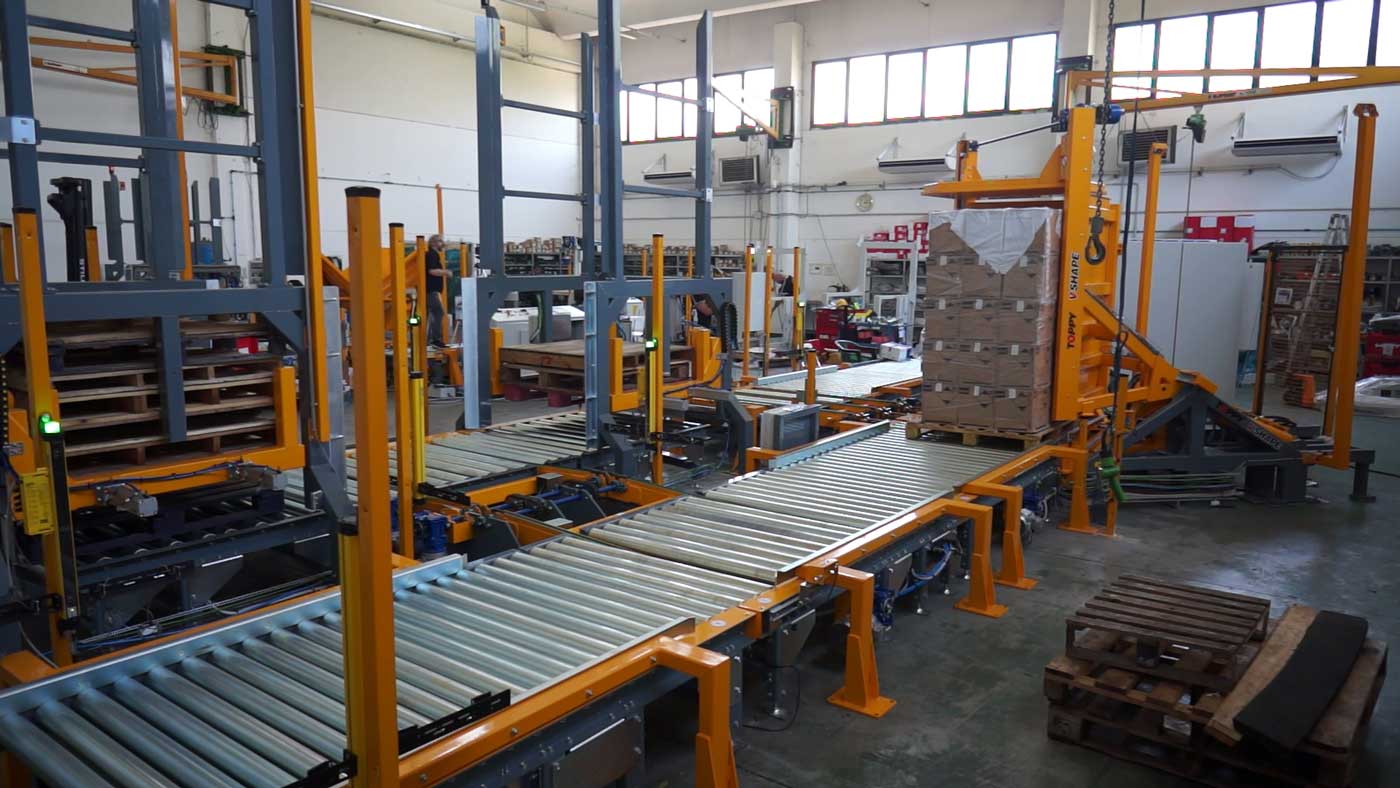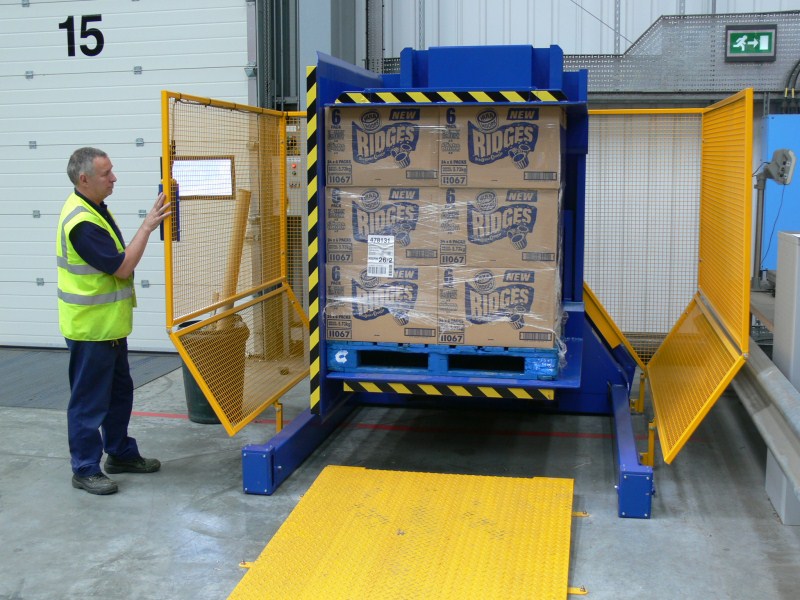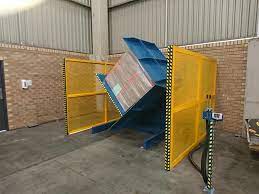Pallet Changing Machine: What’s the Safest Way to Swap Loaded Pallets?
Handling fully loaded pallets, especially with heavy materials like steel products, is a daily task filled with risk. You worry about your team's safety, the potential for costly product damage, and the slow, inefficient process of manually swapping pallets. I’ve been in countless factories and have seen the consequences of a pallet transfer gone wrong: injured workers, halted production lines, and rejected shipments. It’s a constant operational headache that gnaws at you, knowing that a single incident could have significant financial and human costs. This is a problem that requires more than just better training; it demands a real engineering solution.
The safest way to swap loaded pallets is by using a dedicated, automated pallet changing machine. These systems are engineered to securely clamp and support the entire load before performing a controlled transfer. This is done by either inverting the load 180 degrees or gently pushing it from one pallet to another. This process completely removes the need for dangerous manual lifting and minimizes the risks of operator injury and product damage that are common with forklift-based methods.

But I know that for a practical business leader like you, "safety" is just the starting point. The real questions are about how this technology fits into your existing operations, how it impacts your bottom line, and what type of machine is truly the right fit for your specific products. As an engineer who has built these machines and helped clients integrate them for years, I want to share my insights. Let's go beyond the sales pitch and break down what really matters when choosing and implementing a pallet changing solution.
How do pallet changers improve operational safety and reduce injuries?
You see your crew on the factory floor, wrestling with heavy pallets day in and day out. Every time a worker bends to manually adjust a load or a forklift makes a precarious maneuver to swap a pallet, you see a potential for injury. These aren't just abstract risks; they are real threats to your people and your operation's stability. The long-term costs of musculoskeletal disorders and the immediate impact of a sudden accident can disrupt productivity and damage team morale. You know there has to be a better way. The solution is to remove the human body from the equation in these high-risk tasks. A pallet changer creates a predictable, contained, and secure process that protects your most valuable asset: your people.
Pallet changers fundamentally improve operational safety by automating the entire pallet swapping process. They use powerful and precise clamping systems to secure the load, then employ a controlled mechanical action to transfer it. This completely eliminates manual handling, which is the primary cause of back injuries, strains, and other physical harm. By containing the operation within a guarded machine, the risk of accidents from falling or shifting goods is also drastically reduced.

The Mechanics of Injury Prevention
Let's get specific. The most common injuries in logistics and manufacturing are musculoskeletal disorders (MSDs), especially to the back, shoulders, and knees. These are caused by repetitive strain, heavy lifting, and awkward postures—all of which are required in a manual pallet swap. A worker trying to shift a 1,000 kg load, even with a forklift's help, is putting their body in a vulnerable position. A pallet changer takes on 100% of this physical work. The operator simply places the pallet with a forklift or lets a conveyor do the work, and then pushes a button. The machine performs the heavy lifting and precise movements in a guarded, controlled environment.
I remember visiting a client's wire drawing facility. They had two near-miss incidents in a single month from heavy coils shifting on a pallet during a transfer with a forklift. The team was nervous, and management was concerned about a serious accident. After we installed a pallet inverter, their safety manager told me it was the best investment they'd made all year. It wasn't just about the documented reduction in risk; it was about the team's confidence and the peace of mind that comes from having a safe, reliable process.
Controlled vs. Uncontrolled Environments
Think about the difference between swapping a pallet with a forklift versus a pallet changer. The forklift method is an "uncontrolled" process. It relies heavily on operator skill, visibility (which is often limited), and the stability of the load itself. A slight misjudgment can lead to a tipped pallet. A pallet changer, however, creates a "controlled" environment.
- Containment: The machine is typically enclosed with safety fencing.
- Secure Clamping: The load is held firmly by top plates and side walls before any movement occurs.
- Predictable Motion: The machine follows the exact same safe, engineered motion path every single time.
Risk Assessment: Manual vs. Automated
When we break down the risks, the difference becomes crystal clear. A formal risk assessment would score the two methods very differently.
| Risk Factor | Manual / Forklift Method | Pallet Changer Method |
|---|---|---|
| Worker Strain/Injury | High | Negligible |
| Product Damage | Moderate to High | Low |
| Load Tipping Hazard | Moderate | Very Low |
| Operational Consistency | Low (depends on operator) | High (machine-controlled) |
| Required Skill Level | High (skilled forklift operator) | Low (basic machine operation) |
Ultimately, a pallet changer transforms a high-risk, variable manual task into a low-risk, consistent automated process. That is the foundation of a truly safe operation.
What are the key differences between a pallet inverter and a pallet changer?
You're researching solutions, and you come across several terms: pallet inverter, pallet changer, pallet exchanger. They all sound like they do the same thing, but the subtle differences in how they operate are critical. Choosing the wrong machine for your product can be a very expensive mistake. You could invest in a system that damages your goods, operates too slowly, or simply can't handle the load. This confusion can stall a project. As an engineer, I want to cut through the jargon and give you a clear, practical distinction so you can make an informed decision for your facility.
The main difference lies in the mechanism used to transfer the load. A pallet inverter clamps the product and pallet together, then rotates the entire load 180 degrees. The old pallet is now on top and can be removed, and a new pallet is placed before rotating back. A pallet changer, on the other hand, typically clamps the load from the sides and/or top and pushes it horizontally from the old pallet onto a new pallet waiting beside it. This method avoids inverting the load completely.

Deep Dive: The Pallet Inverter
The pallet inverter is a workhorse for stable, robust loads. Think of bags of cement, boxed goods, or frozen blocks. The process is simple and fast:
- A palletized load is placed into the machine.
- Clamping plates secure the load from the top and bottom.
- The entire unit rotates 180 degrees.
- The original pallet is now on top, easily accessible for removal by a forklift.
- The new pallet is positioned, and the load is lowered onto it.
The key advantage here is speed and simplicity, especially for freestanding models. Because it turns the product upside down, it's perfect for goods that are not orientation-sensitive. In my experience, industries like food processing (for removing freezer spacers) and building materials have great success with inverters. The clamping pressure is adjustable, but it's important to ensure your product can withstand being held and inverted.
Deep Dive: The Pallet Changer (Pusher Type)
The pallet changer, often called a pallet exchanger or pusher, is the solution for delicate or orientation-sensitive loads. Imagine trying to invert a pallet of open-top buckets, tall bottles, or stacked pails. It would be a disaster. The pallet changer solves this problem:
- The original pallet and load are conveyed or placed into the machine.
- A new pallet is placed in the adjacent bay.
- Side walls and sometimes a top plate move in to square up and secure the load.
- A pusher plate gently slides the entire load horizontally from the old pallet to the new one.
- The pusher retracts, the clamps release, and the newly palletized load exits.
This method is gentler because it avoids the tipping motion of an inverter. It is the only safe automated option for many products in the chemical, pharmaceutical, and beverage industries.
Making the Right Choice for Your Steel Plant
For a steel operation like yours, the choice depends entirely on what you're handling at the packaging stage.
| Feature | Pallet Inverter | Pallet Changer (Pusher) |
|---|---|---|
| Mechanism | 180° Inversion | Horizontal Push-off Transfer |
| Ideal For | Boxed fasteners, small stable steel parts, bagged materials. | Stacked sheets, delicate components, or any load that cannot be tipped. |
| Product Stress | Clamping pressure + full rotation. | Clamping pressure + sliding friction. |
| Footprint | Often more compact and square. | Typically more linear and rectangular. |
| Flexibility | Less flexible for varied loads. | More adaptable to unstable or sensitive items. |
My advice is to analyze the final packaged form of your products. If you are shipping heavy, stable boxes of steel components, a robust pallet inverter offers speed and efficiency. But if you are handling anything that has a "this way up" requirement or could shift if tilted, a pallet changer is the safer and more logical choice.
How can I integrate a pallet changer into my existing, aging production line?
You look at your factory floor, a layout that has been optimized over years, maybe even decades. Your production lines are reliable, but they are also fixed. The thought of disrupting this flow to install a large new piece of equipment can be overwhelming. Where will it fit? Will it cause a bottleneck? How much production will I lose during installation? These are the practical concerns that can stop a good project dead in its tracks. I understand this completely. However, modern machine design and a strategic approach to integration can allow you to add this vital capability with surprising ease and minimal disruption.
Integrating a pallet changer into an aging line is achieved by treating it as a module. It can be installed as a standalone, forklift-fed station offline, or connected directly to the line using buffer conveyors. Careful planning of the layout, electrical connections, and safety systems ensures it complements, rather than disrupts, your existing workflow. The key is a partner who understands plant flow, not just machinery.

Standalone vs. Fully Integrated Systems
The first major decision is the level of automation. You don't have to go from zero to fully automated in one step.
- Standalone Station: This is the simplest approach. You place the pallet changer in a convenient, open area. A forklift brings a load, the machine swaps the pallet, and the forklift takes the new load away. The pros are lower initial cost, flexible placement, and zero disruption to your main line during installation. The con is that it remains a labor-dependent process.
- Fully Integrated System: This involves connecting the pallet changer directly into your packaging line with infeed and outfeed conveyors. The pros are high throughput, reduced labor, and a seamless flow. The cons are a higher initial investment and the need for careful planning to avoid creating bottlenecks.
I once worked with a client, a steel processor much like Javier, who had a 20-year-old packaging line. They thought integration was impossible due to space constraints. We performed a simple 3D scan of their facility and designed a compact pallet inverter system fed by a U-shaped conveyor loop. It fit perfectly into a corner they were just using for empty pallet storage. We pre-assembled and tested the entire module in our factory. The on-site installation took just two days over a weekend. On Monday morning, they were running with the new system fully operational, with zero production downtime.
The Critical Role of Conveyors and Buffers
If you choose full integration, conveyors are your friend. They bridge the gap between your existing equipment and the new pallet changer. But here is a key insight many people miss: you must include buffer zones. A buffer, or accumulation conveyor, is a section of conveyor before the pallet changer that can hold one or two pallets. This decouples the pallet changer from your main line. If your main line has a brief stop, the pallet changer can keep working from the buffer. If the pallet changer needs a moment to cycle, the main line can keep feeding pallets into the buffer. This small addition prevents the new machine from ever becoming a bottleneck and is crucial for maintaining high OEE (Overall Equipment Effectiveness).
Safety System Integration
This is non-negotiable. When you add a new machine, you must integrate its safety system with your existing line. This means the pallet changer's emergency stops, light curtains, and safety gates must be wired into the line's master safety relay or safety PLC. In a properly integrated system, pressing an E-stop button anywhere in that zone will safely stop all associated equipment, including the conveyors and the pallet changer itself. A good supplier won't just sell you a machine; they will provide a full electrical schematic showing how to achieve this critical safety link.
What's the real ROI of a pallet changing machine beyond just safety?
As a business owner, you know that safety is paramount, but you also have to answer to the numbers on a spreadsheet. A pallet changer is a significant capital expenditure, and justifying it solely on "injury avoidance" can be difficult. Your financial team needs to see a clear path to a return on investment (ROI). How does this machine pay for itself, and how quickly? I've helped dozens of clients build the business case for these machines, and the financial benefits are often more substantial and faster to realize than they initially expect. Let's look at the concrete, measurable ways a pallet changer boosts your bottom line.
The ROI of a pallet changer is driven by four key areas: massive savings on pallet costs by shipping on cheap pallets, significant reductions in labor costs, the near-elimination of product damage during transfer, and increased logistical speed and flexibility. When combined, these factors often result in a payback period of less than 24 months.

The Pallet Cost Arbitrage
This is often the single biggest source of savings. Inside your plant, you may need high-quality, durable plastic or metal pallets that work well with your automated systems and conveyors. These can cost $70, $100, or even more. But your customers don't want to pay for or return these expensive pallets. You need to ship products on standard, one-way wooden pallets that might only cost $15. A pallet changer allows you to run your entire internal operation on high-quality pallets and then, at the last moment before shipping, transfer the load to a cheap disposable pallet. The expensive pallets never leave your facility.
Let's do some simple math.
- Cost of high-quality internal pallet: $80
- Cost of one-way shipping pallet: $15
- Saving per pallet shipped: $65
If you ship 50 pallets a day for 250 days a year, the annual savings are: 50 250 $65 = $812,500. This alone can justify the investment.
Quantifying Labor and Efficiency Gains
The next area is labor. A manual or forklift-based pallet swap is slow and labor-intensive. It might take two workers 10 minutes to do it safely. A pallet changer can perform the same task in 2 minutes with one operator overseeing it. You're not just saving on wages; you are freeing up skilled forklift operators to do more value-added work, like loading trucks, instead of performing a repetitive, low-skill task.
Calculating the Full ROI
Let's put it all together in a sample ROI calculation for a facility shipping 50 pallets/day.
| Cost Savings Category | Calculation Example | Estimated Annual Savings |
|---|---|---|
| Pallet Cost Arbitrage | 50 pallets/day 250 days $65/pallet | $812,500 |
| Labor Savings | 1.5 workers re-allocated * $50,000/yr salary | $75,000 |
| Product Damage Reduction | 0.25% damage rate on $50M of goods | $125,000 |
| Forklift Damage Avoidance | Reduced wear/damage to expensive pallets | $10,000 |
| Total Annual Savings | $1,022,500 |
If the total installed cost of the pallet changer system is $150,000, the payback calculation is simple:
Payback Period = Total Investment / Total Annual Savings = $150,000 / $1,022,500 = 0.15 years, or less than 2 months.
Even with much more conservative numbers, the payback period is almost always compelling. It transforms the pallet changer from a "safety expense" into a strategic, profit-generating asset.
Conclusion
A pallet changing machine is more than just safety equipment. It is a strategic asset that enhances safety, drives operational efficiency, and delivers a strong, measurable return on investment.




